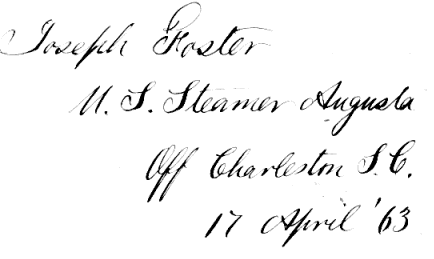 he owners of old books sometimes reveal themselves to us with startling immediacy and intimacy. Here is a ghost who has haunted me ever since we first met. His name is Joseph Foster and he turns up in an old mathematics text, Elements of Geometry and Trigonometry, published in 1855. Although the author's name was Charles Davies, the name Legendre is stamped on its calf cover. The great French mathematician Legendre had long since died. Davies wrote other books and invoked other famous French mathematicians. By saying that his work is based on Legendre, Davies attempts to add luster to what is a solid, but otherwise unremarkable high school trig text.
he owners of old books sometimes reveal themselves to us with startling immediacy and intimacy. Here is a ghost who has haunted me ever since we first met. His name is Joseph Foster and he turns up in an old mathematics text, Elements of Geometry and Trigonometry, published in 1855. Although the author's name was Charles Davies, the name Legendre is stamped on its calf cover. The great French mathematician Legendre had long since died. Davies wrote other books and invoked other famous French mathematicians. By saying that his work is based on Legendre, Davies attempts to add luster to what is a solid, but otherwise unremarkable high school trig text.
But our interest is in Foster. He was a 14-year-old schoolboy in New Hampshire's Portsmouth Academy when he received this brand new book, and he inscribed it in a flowing young hand.

Like Joseph Whittenburg, however, Foster has signed his book a second time, on another page. This time the schoolboy flourish is gone, and what he adds to his name catches us off guard. Indeed, it takes my breath way. This time, we read: "Joseph Foster, U.S. Steamer Augusta, off Charleston, S.C., 17 April, 1863."
Foster had joined the Union Navy, and was now part of the Charleston Blockade in the Civil War. He's on the Augusta, a steam-powered, paddle-driven Union gunboat. America had, for the first time, sent steam off to war, and had sent Foster off with it. Ten days before Foster inscribed his book the second time, the Augusta had joined Admiral duPont's attack on Charleston. That attack had failed miserably. The Union Navy retreated into the Bay and duPont was relieved of his command.
Now the ghost of Foster reaches across the years to tell us he was there – that he saw men die. This old text on geometry and trigonometry was there with him. So I went looking for Foster and caught up with him in a library in Portsmouth. He'd been 22 years old during the defeat at Charleston – eight years from the schoolboy days when he first got the book, and he had carried it into war with him.
 Foster shipped on three of the new Union gunboats during the War. The Augusta was a 1310-ton sidewheeler. He also shipped on the Acacia, a 300-ton screw-driven steamer; and finally on the Commodore MacDonough, a 532-ton sidewheel ferry. It sank on August 23, 1865 as it was being towed from Port Royal back to New York after the War. Only Foster managed to save any personal effects and all he saved were some books and papers. He saved this old geometry book.
Foster shipped on three of the new Union gunboats during the War. The Augusta was a 1310-ton sidewheeler. He also shipped on the Acacia, a 300-ton screw-driven steamer; and finally on the Commodore MacDonough, a 532-ton sidewheel ferry. It sank on August 23, 1865 as it was being towed from Port Royal back to New York after the War. Only Foster managed to save any personal effects and all he saved were some books and papers. He saved this old geometry book.
Foster continued to serve in a variety of storekeeper and paymaster roles until he retired in 1902 at the rank of rear admiral. By then, he had lived all the way through the Spanish American War, but he had seen no more combat. Back in Portsmouth, he ended his life writing histories and biographies which may now be found in the Portsmouth Athenaeum. He died on May 19th, 1930, three months before I was born. His old school became the city library in Portsmouth, while his old book found its way to my shelf.
It's clear from Foster's marginal notes that he bogged down after studying plane geometry, and yet he'd carried this book through the War, and I think I know why. It was a young man's time out of war – a retreat into a clean and beautiful place. My old book had been Foster's handhold on sanity in a world that had, for a season, lost its wits.
C. Davies, Elements of Geometry and Trigonometry. from the Works of A.M. Legendre, Revised and Adapted to the Course of Mathematical Instruction in the United States. (New York: A.S. Barnes & Co., 1855).
I am most grateful to Caroline Eastman of the Portsmouth Athenaeum, 9 Market Square, Portsmouth, NH 03801, for her help in finding local biographical material on Foster.
For more on ships of the kind Foster sailed during the Civil War, see: T. Gibbons, Warships and Naval Battles of the Civil War. (New York: W.H. Smith Publishers, Inc., 1989).